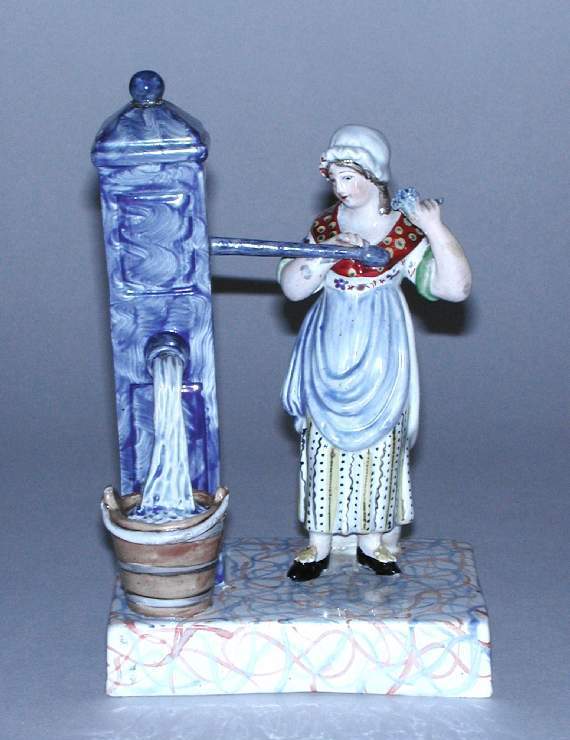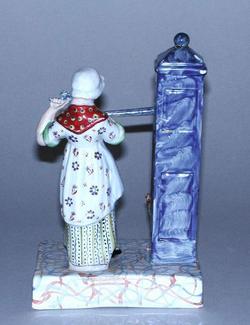Current Location: In storage
Titles
Girl pumping water
Maker(s)
Production:
Unidentified factory
Entities
Categories
Description
Earthenware figure, moulded and modelled, lead glazed and painted with polychrome enamels.
Earthenware figure of a girl working a pump. She stands to the right, holding the handle in her right hand, and the water flows into a bucket in front of the pump. She wears a mob cap, a red scarf with yellow spots, a pale blue apron tucked up and a flowered dress over a skirt with wavy red, blue spot and yellow stripes; her shoes are black with yellow rosettes. She holds a ladle (?) in her raised left hand. The pump is painted dark blue, with a stiff brush to suggest iron. The back is fully shaped and decorated. The base is a rectangular plinth painted with pale blue and red curved lines, to imitate marble. The underside is recessed and glazed with an off-centre vent hole.
Notes
History note: Captain Reynolds Collection, London, sold to Messrs Gill and Reigate. Bought by Mr Stoner, London, from whom purchased in 1910 by Dr J.W.L. Glaisher, FRS, Trinity College, Cambridge. Dr Glaisher paid £125 for this and fourteen other pieces, as part of a purchase of 35 figures and figure groups.
Legal notes
Dr J. W. L. Glaisher Bequest
Measurements and weight
Depth: 7.6 cm
Height: 15.8 cm
Width: 10.2 cm
Acquisition and important dates
Method of acquisition: Bequeathed
(1928-12-07)
by
Glaisher, J. W. L., Dr
Dating
19th Century, Early
Circa
1810
CE
-
Circa
1820
CE
Note
Pearlware figures decorated with enamels were in production by 1780. They were generally made at smaller potteries and are rarely marked. They drew on a variety of sources, including sculpture and porcelain figures. Classical, biblical, mythological and literary subjects were popular, as were animals and representations of rural life, seasons and trades. From the early 19th Century, scenes from everyday life and topical events were also common. These early figures are moulded, perhaps with moulded or modelled parts added, the bases often formed separately. After around 1810-1820, figures are often more vibrantly coloured and by c.1835 earlier methods had largely given way to three-part press-moulding, enabling cheaper production of figures for a growing market.
This figure perhaps stands for ‘water’, as part of a series representing the elements. The rectangular base, together with the number of modelled parts and detailed painting in muted colours, suggests an early 19th century date.
Components of the work
Decoration
Parts
References and bibliographic entries
Identification numbers
Accession number: C.950-1928
Primary reference Number: 76432
Old object number: 3212
Stable URI
Audit data
Created: Saturday 6 August 2011
Updated: Wednesday 11 June 2025
Last processed: Tuesday 15 July 2025
Associated departments & institutions
Owner or interested party:
The Fitzwilliam Museum
Associated department:
Applied Arts





